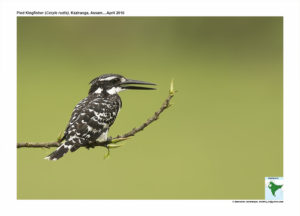Pied Kingfisher

Pied Kingfisher Ceryle rudis
Etymology:
- Ceryle : Greek word Ceryle – kerulos mythical bird associated with Halcyon ( Kingfisher)
- Rudis : Latin word for Rude, Wild
Vernacular names: Sind: Kingar, Hindi: Kaudiala Kilikila, Kauriala, Sans: Kapdrik meenrak, Kash: Hor kola tonch, Pun: Kilkila, Bi: Karona, M.P: Chitla Kilkila, Ben: Phatka machhranga, Karikata, Sufaid tont, Duddru, Ass: Pokhora masroka, Cachar: Dao natu meberang, Hanumanta sorai, Mani: Ngarakpi, Wakrek, Gomera pilihuduwa, Naga: Inrui gna, Guj: Kabaro kalkaliyo, Kutch: Kirkiria, Mar: Kilkila, Kavda dhivar, Ta: For kingfishers – Meenkotti, Te: Neella buchigadu, Mal: Pulli ponman, Kan: Kappu bili meenchulli, Sinh: Kallapu pilihuduwa
Distribution in India: Wide spread Resident.
Description: Size of 25 cm. It is a medium-sized kingfisher with black-and-white plumage. The male of nominate race has black crown and crest, white stripe above eye, black eye band to hindneck, white throat and collar; black upperparts with white edgings, rump barred black and white, white patch on wing-coverts; white below with two black breast bands, the upper broad and often almost broken in middle, lower one narrower; bill almost entirely black; iris dark brown; legs and feet blackish. The adult female has only single breast band, narrower and often broken in center.
Habitat: It is found in small and large lakes, large rivers, estuaries, coastal lagoons, mangroves and sandy and rocky coasts, dams and reservoirs with either fresh or brackish water; also streams and smaller fast-flowing rivers, marshes and paddy fields, and even feeding from roadside ditches. Found from Seashore up to 2500 m.
Food Habits: It eats mainly fish. Also eats aquatic insects, water-bugs,, water beetles , dragonfly nymphs and adults, mayflies , lacewings, stoneflies, caddis flies; also flies, butterflies and moths, amphibians , crayfish, prawns, shrimps and isopods. It hunts by scanning from perch, bobbing head and flicking tail, and then diving down, hitting water with a splash, returning with prey carried crosswise in its bill. Small fish may be swallowed in flight; larger ones taken back to perch and bashed repeatedly, (up to 113 times for a 9-cm fish), before being swallowed head first. Also regularly hovers, before plunging down to take prey in water; in still, calm conditions hovering used for dives. Hovering allows it to go out over 3 km from shoreline; flies low over water then rises 2–10 m, with body nearly vertical, bill held down and wings beating rapidly; may move or drop down slightly and resume hovering before diving down; if successful, will swallow prey on the wing without prior beating on branch.
Breeding Habits: They breed in Mar-June in Kashmir, in Feb-April in North India, in Nov- April in South East India. They breed in pairs, or in family groups consisting of primary helpers (1-year-old son of one or both of nesting pair) and/or secondary helpers (unrelated males which are not breeding), there be several secondary helpers in areas with poor food resources. The primary helper involved at onset of breeding, bringing food to one of the pair, also helps to mob predators, joins in communal displays and helps to feed nestlings. The secondary helpers are initially driven off by male but more likely accepted soon after eggs hatch, particularly if food scarce. The male courtship-feeds female during nest-digging, laying and incubation; mating usually near nest, often follows courtship feeding. They Nest in earthen bank, over water occasionally in flat grassy ground; excavated by pair and any primary helper by jabbing at soil with partially opened bill and then kicking soil backwards with legs; digging of tunnel usually takes 26 days. The nest-tunnel is horizontal or slightly inclined, and ends in unlined chamber; nestlings dig soil from walls for sanitation, so chamber becomes wider and lower with time. They lay a clutch 1-7 eggs. The hatching is asynchronous over 3 days. The female parent incubates and broods exclusively at night and also major part of day, assisted by male; young hatch blind and naked, initially fed mainly by male parent and any helpers, later also by female. The fledging period is 23-26 days. The young ones after 14 days of fledging can fish for themselves, but stay with parents for several months.